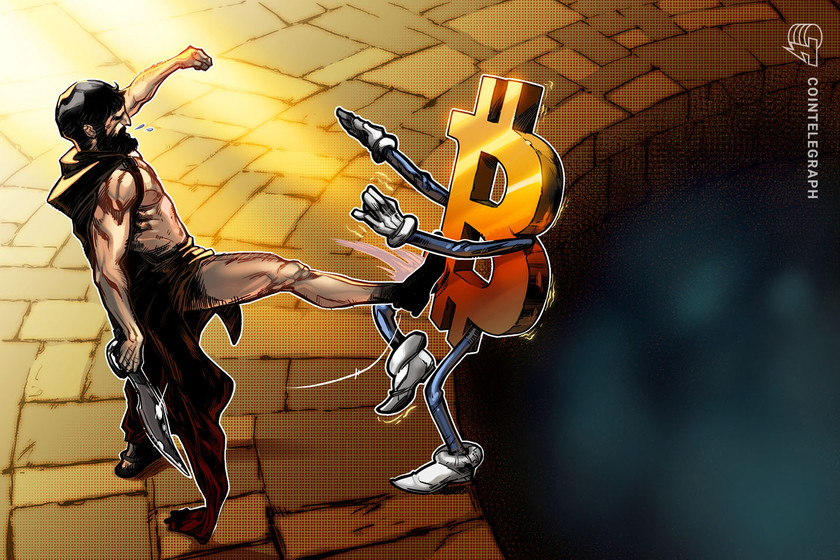Bitcoin ‘faces headwinds’ as US money supply drops most since 1950s


Research from Bloomberg Intelligence argues that liquidity conditions still do not favor a continuation of the Bitcoin rally.
Bitcoin (BTC) and crypto may yet see a long-term correction thanks to central banks keeping liquidity tight, Bloomberg warned.
In its latest research, Bloomberg Intelligence revealed a cool stance on the ongoing 2023 crypto market rally.
Bloomberg: Expecting BTC price to hold “may be illogical”
Despite gaining 70% in Q1, Bitcoin is not convincing everyone that it will continue to climb or even maintain current levels near $30,000.
Examining the macroeconomic climate, Bloomberg Intelligence became the latest voice to note the close relationship between crypto performance and global central bank liquidity levels.
As inflation bites, banks have been withdrawing liquidity from the economy, with risk assets declining as a result — including crypto. The United States Federal Reserve’s quantitative tightening (QT), which began in late 2021, coincided with the current all-time high for Bitcoin.
Despite the recent banking crisis, Bloomberg noted that plunging M2 money supply and bank deposits mean that liquidity continues to be squeezed.
“Risk assets typically rise and fall on the back of liquidity and plunging US money supply, and bank deposits indicate headwinds for cryptos,” it stated in an analysis uploaded to Twitter by Bloomberg Intelligence senior macro strategist Mike McGlone.
“It may be illogical to expect that stock market, crude oil, copper and the Bloomberg Galaxy Crypto Index (BGCI) to sustain recent bounces with year-over-year measures of money supply and commercial bank deposits falling around 2% — the most in our database since 1959.”
The misgivings come as Bitcoin faces a battle to flip historical resistance back to support, with bulls as yet unable to effect major change.
When it comes to liquidity, meanwhile, others have already noted that crypto now responds to the actions of central banks other than the Fed, and both China and Japan have enacted liquidity injections this year.
“A top question at the start of April is what stops the contracting liquidity?” Bloomberg, meanwhile, continued.
“Most central banks still tightening may portend a lower plateau for the BGCI. Our take is Bitcoin faces headwinds but will eventually transition to trade more like gold and Treasury bonds.”
A thousand words in a chart – liquidity rug-pull:
It may be illogical to expect the #stockmarket, #crudeoil, #copper and #Bitcoin to sustain recent bounces with year-over-year measures of money supply and commercial bank deposits falling the most in our database since 1959. pic.twitter.com/O36SxGdK48— Mike McGlone (@mikemcglone11) April 5, 2023
U.S. dollars gives Bitcoin heat
BTC/USD traded around $28,100 at the time of writing on April 6, according to data from Cointelegraph Markets Pro and TradingView.
Related: Latest Bitcoin price data suggests double top above $200K in 2025


In a potential short-term tailwind for risk assets, the U.S. Dollar Index (DXY) saw fresh losses, abandoning a modest comeback to drop back below 102.
Analyzing the situation, popular Crypto Twitter account Cold Blooded Shiller remained tentatively optimistic about the outcome of BTC’s price.
$DXY rejecting at the 4h resistance zone.
Indexes doing the next leg down today into some good regions.$NQ diverging the hourly on the last low and close to Daily pivot level.
RSI’s cooled off.
Your prayers may just be working. But we need more energy. https://t.co/NEqizbwvUr pic.twitter.com/f9hIgteuzn
— Cold Blooded Shiller (@ColdBloodShill) April 6, 2023
Analyst Justin Bennett nonetheless flagged a distinct range still intact for the DXY, predicting a rebound to come.
“All the ‘dollar is dead’ chants are about to be silenced by what is still the global reserve,” he warned.


Related: Crypto winter can take a toll on hodlers’ mental health
The views, thoughts and opinions expressed here are the authors’ alone and do not necessarily reflect or represent the views and opinions of Cointelegraph.













